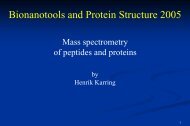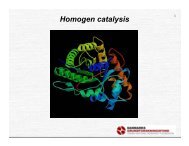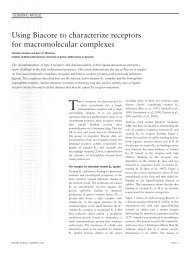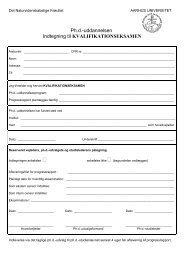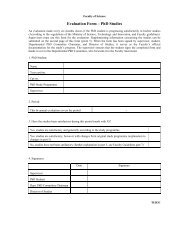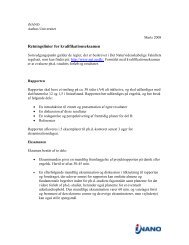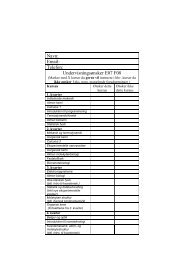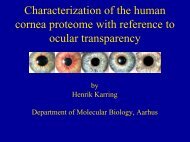Functional genomics by mass spectrometry
Functional genomics by mass spectrometry
Functional genomics by mass spectrometry
Create successful ePaper yourself
Turn your PDF publications into a flip-book with our unique Google optimized e-Paper software.
26<br />
separated <strong>by</strong> one- or two-dimensional gel electrophoresis. Protocols<br />
for high sensitivity preparation of gel separated protejns<br />
have been published [16-18]. Proteins an\ tiest degraded<br />
into peptides <strong>by</strong> sequence specific proteases such as trypsin.<br />
Peptides are preferred for MS analysis, since proteins cannot<br />
easiJy be eluted from gels without detergents like SDS (which<br />
are detrimental to <strong>mass</strong> <strong>spectrometry</strong>) and because large protejns<br />
are usually heterogeneous and hence possess no single<br />
molecular weight which can be related to the corresponding<br />
entry in a sequence database. The <strong>mass</strong>es of a set of peptides<br />
can be measured <strong>by</strong> matrix assisted laser desorption ionization<br />
(MALDl) where a co-precipitate of light absorbing matrix<br />
(usually a-cyano-4-hydroxycinnamic acid or dihydroxy benzoic<br />
acid) and the peptide solution is irradiated with a short<br />
pulse of VY light in the vacuum. Same of the released peptides<br />
are ionized <strong>by</strong> attachment of protons and are accelerated<br />
in a strong electric fieid. After being turned around <strong>by</strong> an<br />
energy correcting ion mireDethey are then detected on a channeltron<br />
detector. The result of this measurement is a time of<br />
flight distribution of the peptides in the supernatant of the<br />
trypsin digested protein (TOF <strong>mass</strong> <strong>spectrometry</strong>). After determining<br />
the peak centroids and calibrating the spectrum, for<br />
example on trypsin auto-digestion products, a set of highly<br />
accurate peptide <strong>mass</strong>es is obtained. With state of the art<br />
MALDI <strong>mass</strong> spectrometers, peak resolution of about<br />
10000 and a <strong>mass</strong> accuracy of a few parts per million is<br />
flOWpossible. Recording the <strong>mass</strong> spectrum can be done manually<br />
in a few minutes and has also been entirely automated<br />
using fuzzy logic feedback control [19]. Fig. la shows the<br />
peptide <strong>mass</strong> map obtained fully automatically from a gel<br />
separated protein from the malaria parasite.<br />
The MALDI peptide <strong>mass</strong> mapping, or '<strong>mass</strong> fingerprinting'<br />
method has the advantage of being scalable. Many sampies<br />
can be deposited on a single probe holder and measured<br />
in a single run. Together with automated and high sensitivity<br />
preparation of the proteins for analysis, hundred s of proteins<br />
can be handled in this format.<br />
Vnfortunately, not all protein s are amenable to identificalian<br />
<strong>by</strong> peptide <strong>mass</strong> mapping alone. A large percentage of<br />
human proteins are still not represented full length in sequence<br />
databases, small proteins sometimes do not result in<br />
a sufficient number of tryptic peptides for unambiguous identification<br />
and mixtures of proteins can only be 'deconvoluted'<br />
to their respective entries in the databases with special interpretation<br />
[20,21].In many of those cases, a further step - <strong>mass</strong><br />
spectrometricsequencingof the peptides- is required.<br />
Electrospray <strong>mass</strong> <strong>spectrometry</strong> is a different but complementary<br />
method to identify proteins [I]. A solution containing<br />
the peptides is pumped through a metal capillary and dispersed<br />
at high voltage, resulting in rapidly evaporating, peptide<br />
containing droplets. After desolvation, the peptide molecules<br />
remain charged <strong>by</strong> attachment of Olle or a few protons<br />
and are drawn into the vacuum of a <strong>mass</strong> spectrometer. In the<br />
<strong>mass</strong> spectrometer, the ions are separate d <strong>by</strong> dynamic electric<br />
fields according to their <strong>mass</strong> to charge ratios. After a <strong>mass</strong><br />
spectrum is obtained, the instrument can be instructed to pass<br />
only a particular ion species into a 'collision chamber' where<br />
this ion species collides with nitrogen or argon gas at low<br />
pressure. Multiple impacts result in fragmentation of the peptide<br />
species, usually along the peptide band. The C-terminal<br />
containing fragments are designated Y"-ions and the N-terminal<br />
containing fragments are designated B-ions [22]. A series<br />
J.S. Andersen, M. MannlFEBS Letters 480 (2000) 25-31<br />
a 100 1763.846 2291.067 1462.617<br />
T<br />
842.510 MH+<br />
~<br />
.E il!<br />
] 50<br />
"<br />
." > ol<br />
";j<br />
'"<br />
1460 1465<br />
o 2000<br />
b 100 664.31<br />
~<br />
.E<br />
il!<br />
8<br />
..s 50<br />
"<br />
.:':<br />
1;j<br />
";j<br />
'"<br />
451.20<br />
(M+2H)2+<br />
578.62 *<br />
664.31<br />
617.57 I 707.83<br />
o 400 600 700 800 900<br />
500<br />
c 100 B2<br />
~<br />
.E il! "<br />
,Ej50<br />
."<br />
~ ol<br />
;:!<br />
B,<br />
Y'; Y'6<br />
693.37 822.41<br />
o ~<br />
800<br />
B7 --r-<br />
200 400<br />
600<br />
mIz<br />
Y<br />
662 66<br />
Y"<br />
Y" 8<br />
7 1098.55<br />
985.47<br />
1000<br />
!IL<br />
1200<br />
Fig.!. a: PepIide <strong>mass</strong> map of a Plasmodium falciparum malaria<br />
protein obtained from an in-gel digest of a spot from a 2D gel. The<br />
list of <strong>mass</strong>es unambiguously identified gene 14-3-3 in the database<br />
with 13 peptides matching the caIculated tryptic peptide <strong>mass</strong>es<br />
within 30 ppm. Two tryptic peptides (T) were used for calibration<br />
of the spectrum. (The proteins were analyzed using the automated<br />
analysis at Protana AiS, Odense, Denmark.) b and c: Identification<br />
of a human protein <strong>by</strong> nanoelectrospray <strong>mass</strong> <strong>spectrometry</strong>. b: Mass<br />
spectrum of the tryptic peptides from an in-gel digest. Marked<br />
peaks were fragmented and correspond to peptides from Nop5.<br />
c: Fragment <strong>mass</strong> spectrum of the doubly charged peptide ion at<br />
mlz 664.31. The sequence tag E-Y-I/L is derived from the <strong>mass</strong><br />
difference of peptide fragments. The sequence, together with the<br />
start and end <strong>mass</strong> of the fragmentation series and the peptide<br />
<strong>mass</strong>, was combined into the search string (693.34)EYL(l098.52)<br />
and searched in a non-redundant database. The retrieved sequence<br />
TQLYEYLQNR was matched against the tandem <strong>mass</strong> spectrum.<br />
The position of the assigned series of N-terminal (B-ions) and C-terminal<br />
(Y"-ions) are marked.<br />
of B- or Y"-ions spelIs out a partial sequence given <strong>by</strong> the<br />
mblecular weight differences between the fragments (for exampie,<br />
a <strong>mass</strong> difference between three adjacent y" fragment ions<br />
at <strong>mass</strong>es 500, 613, and 684 would spell out the sequence IG<br />
in the C- to N-terminal direction, where I could be isoleucine<br />
or leucine which have the same <strong>mass</strong> and cannot be distinguished).<br />
In the last few years the triple quadrupole <strong>mass</strong> spectrometer,<br />
in which the tiest, isolating, <strong>mass</strong> spectrometer and the<br />
part of the <strong>mass</strong> spectrometer which separates the fragments<br />
were both of the quadrupole type, has largely been displaced<br />
<strong>by</strong> the quadrupole time of flight instrument. In this instrument,<br />
the fragments are detected <strong>by</strong> TOF <strong>mass</strong> <strong>spectrometry</strong>,<br />
like they are in the MALDI method. Resolution and <strong>mass</strong>



